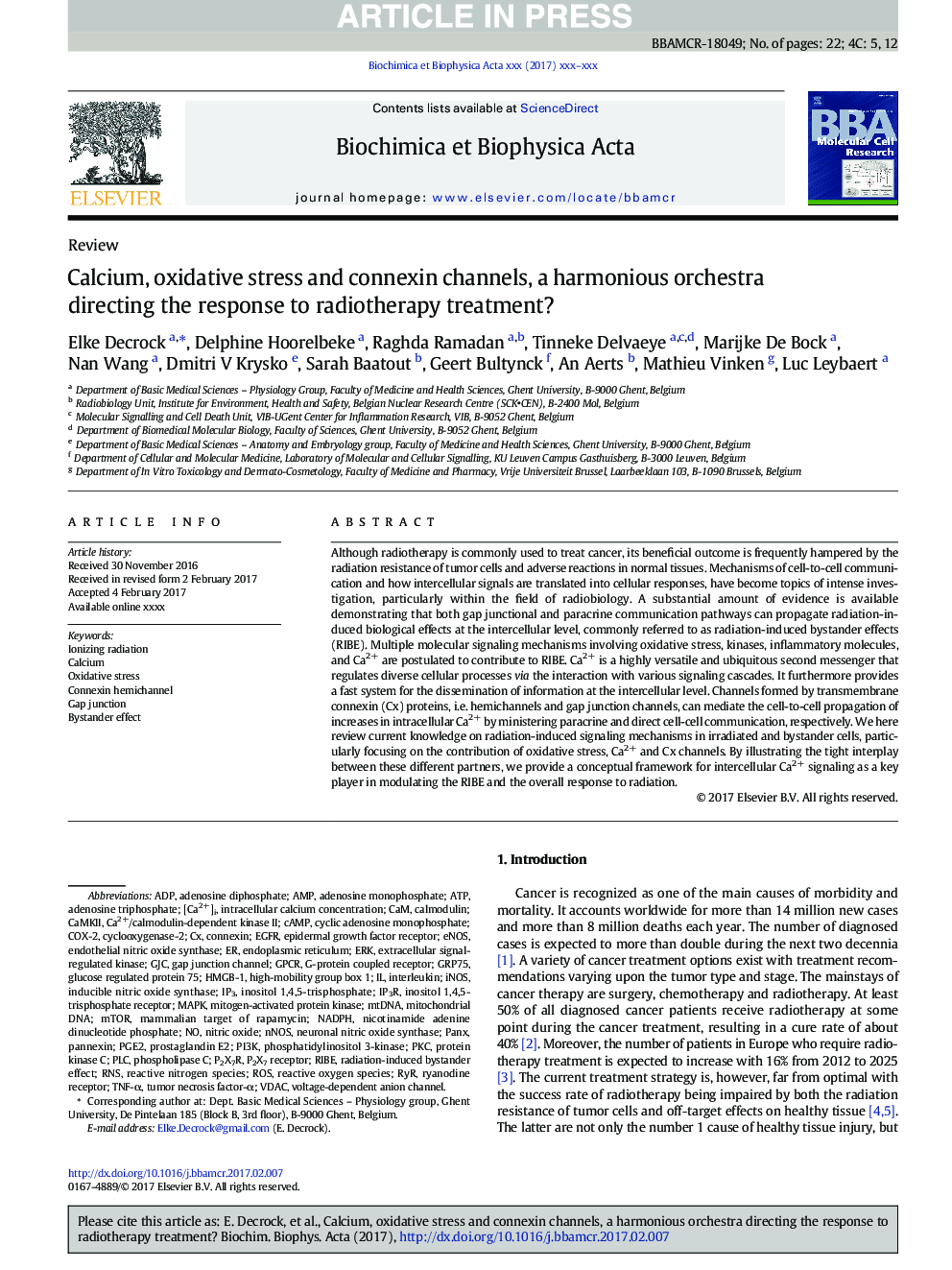| Article ID | Journal | Published Year | Pages | File Type |
|---|---|---|---|---|
| 5508674 | Biochimica et Biophysica Acta (BBA) - Molecular Cell Research | 2017 | 22 Pages |
Abstract
Although radiotherapy is commonly used to treat cancer, its beneficial outcome is frequently hampered by the radiation resistance of tumor cells and adverse reactions in normal tissues. Mechanisms of cell-to-cell communication and how intercellular signals are translated into cellular responses, have become topics of intense investigation, particularly within the field of radiobiology. A substantial amount of evidence is available demonstrating that both gap junctional and paracrine communication pathways can propagate radiation-induced biological effects at the intercellular level, commonly referred to as radiation-induced bystander effects (RIBE). Multiple molecular signaling mechanisms involving oxidative stress, kinases, inflammatory molecules, and Ca2+ are postulated to contribute to RIBE. Ca2+ is a highly versatile and ubiquitous second messenger that regulates diverse cellular processes via the interaction with various signaling cascades. It furthermore provides a fast system for the dissemination of information at the intercellular level. Channels formed by transmembrane connexin (Cx) proteins, i.e. hemichannels and gap junction channels, can mediate the cell-to-cell propagation of increases in intracellular Ca2+ by ministering paracrine and direct cell-cell communication, respectively. We here review current knowledge on radiation-induced signaling mechanisms in irradiated and bystander cells, particularly focusing on the contribution of oxidative stress, Ca2+ and Cx channels. By illustrating the tight interplay between these different partners, we provide a conceptual framework for intercellular Ca2+ signaling as a key player in modulating the RIBE and the overall response to radiation.
Keywords
RyRNADPHmTORP2X7RERKIP3RiNOSPKCPGE2COX-2RNSPLCeNOSCaMKIInNOSADPGPCRIP3grp75EGFRGJCPI3KGlucose regulated protein 75VDACAMPHMGB-1Ca2+/Calmodulin-dependent kinase IIcAMPMitochondrial DNAG-protein coupled receptorinositol 1,4,5-trisphosphateMAPKROS[Ca2+]iAdenosine TriphosphateATPadenosine diphosphateCyclic adenosine monophosphateadenosine monophosphateRadiation-induced bystander effectinterleukinionizing radiationBystander effectOxidative stresstumor necrosis factor-αhigh-mobility group box 1mtDNACAMinducible nitric oxide synthaseendothelial nitric oxide synthaseneuronal nitric oxide synthaseCyclooxygenase-2endoplasmic reticulumintracellular calcium concentrationgap junctionTNF-αPhosphatidylinositol 3-kinasephospholipase CRIBENitric oxidenicotinamide adenine dinucleotide phosphatemammalian target of rapamycinPanxpannexinProtein kinase Cmitogen-activated protein kinaseProstaglandin E2Calmodulinvoltage-dependent anion channelGap junction channelConnexin hemichannelCalciumconnexinextracellular signal-regulated kinasereactive nitrogen speciesReactive oxygen speciesInositol 1,4,5-trisphosphate receptorP2X7 receptorRyanodine receptorEpidermal growth factor receptor
Related Topics
Life Sciences
Biochemistry, Genetics and Molecular Biology
Biochemistry
Authors
Elke Decrock, Delphine Hoorelbeke, Raghda Ramadan, Tinneke Delvaeye, Marijke De Bock, Nan Wang, Dmitri V Krysko, Sarah Baatout, Geert Bultynck, An Aerts, Mathieu Vinken, Luc Leybaert,
